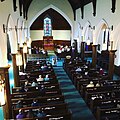History
Evansville's first Episcopalians organized themselves as St. Paul's parish, the first Protestant Episcopal parish in Evansville on January 9, 1836. Rev. Archibald H. Lamon served as the first rector from 1836 to 1844. The congregation met in the first Vanderburgh County Courthouse until January 12, 1840, when the first church building on 1st and Chestnut was consecrated by Bishop Jackson Kemper. [2] : 3 After Rev. Lamon left the congregation in March 1844 to pursue missionary work in Louisiana, the congregation went through a series of rectors as follows:
- Rev. B.H. Hicox (invited 1844, died before assuming duties)
- Rev. William Vaux (1844–1845, educated in England, brought to America by Bishop Kemper, left to become US army chaplain on the western frontier) [4]
- Rev. N.A. Okeson (1845–1846)
- Rev. Colley A. Foster (1847–1856)
- Rev. Anthony Ten Broeck (1856–1857)
- Rev. Sidney Wilbur (1857–1859)
- Rev. Elias Birdsall (1860–1864, left to become the first rector of St. Athanasius Episcopal Church in Los Angeles, the first Protestant Episcopal parish in Southern California) [5]
- Rev. H.W. Spaulding (1865–1867)
- Rev. W.H. Van Antwerp (1868–1874)
- Rev. W.N. Webbe (1874–1879)
- Rev. Theodore I. Holcombe (1880–1881)
- Rev. Charles Morris (1881–1894)
Under the leadership of Rev. Morris, St. Paul's Episcopal parish vestry passed a resolution to build a new church building. The final service in the first church building was held on April 15, 1883. While construction ensued, a congregant and frequent benefactor, Charles Viele, offered the use of Viele Hall (located on 2nd street between Main and Sycamore streets) to St. Paul's parish. The cornerstone for new St. Paul's was laid on September 3, 1883, and construction completed on March 2, 1886, with Bishop D.B. Knickerbacker consecrating the new building. Charles and Mary Viele continued to sponsor further construction on the church grounds – first with a rectory (1886) and later a chapel named in honor of the Viele family (1887). [2] : 39
The next series of rectors were as follows:
- Rev. W. Northey Jones (1894–1897)
- Rev. Joseph Marshall Francis (1897–1899, later became Bishop of Diocese of Indianapolis)
- Rev. Dr. John Davis (1899–1904, a former theology teacher at an Episcopal mission in Japan) [6]
- Rev. William Reid Cross (1904–1911)
- Rev. John Boden (1911–1913)
- Rev. Horace Weeks Jones (1914, died in an automobile accident)
- Rev. A.L. Murray (1914–1918)
- Rev. W.R. Plummer (1918–1923, died during mid-week service in Viele chapel of heart attack)
- Rev. E. Ainger Powell (1923–1931), later became rector of Christ Church Cathedral in Indianapolis [7] [8]
- Rev. Joseph G. Moore (1932–1943)
Rev. Moore served as a dynamic leader not only at St. Paul's but also in the broader Southwestern Indiana community. During the Great Depression when nearby Episcopal churches could not afford full-time clergy, he made time to visit these parishes for services to keep them open. He formed a cadre of laypeople assist him in these services, which became known as the Evansville Associate Mission of Southwestern Indiana. [2] : 71 Rev. Moore also was a strong advocate for civil rights causes. He held the position of National Field Secretary for the Church League for Industrial Democracy, which brought him into contact with activists AJ Muste & Claude C Williams, Leon Trotsky's bodyguard Henry Schnautz, and other socialists of the 1930s. [9] [10] Rev. Moore supported local labor unions and condemned corrupt local elections through the League for Clean Elections. [9] [11] [12]
Rev. Moore also played a significant role in creating better race relations in Evansville. During World War II, Rev. Moore & the vestry invited a group of black workers in the Civilian Conservation Corps & their African-American Episcopalian chaplain to worship at St. Paul's on Sundays - the first documented integrated church service in Evansville. This action was taken despite the bishop's opposition to a previously integrated mid-week service. In addition, Rev. Moore brought future Supreme Court justice Thurgood Marshall to Evansville for help in creating a local chapter of the NAACP. [2] : 79
In 1937, Evansville experienced a severe flood which severely damaged the interior of St. Paul's. The flood damage later contributed to the shorting out of wiring connected to the organ, causing a massive fire on March 27, 1938. [2] : 75 Between the flood and the fire, the interior was gutted and remodeled while the exterior stonework remained.
After Rev. Moore left to become a US army chaplain in February 1943, Rev. Imri Blackburn became rector and served until February 14, 1954, when he resigned to accept a professorship at Seabury Western Seminary. The next series of rectors followed:
- Rev. W. Robert Webb (1954–1971)
- Rev. Richard Wyatt (1972–1978)
- Rev. Thomas N. Sandy (1978–1985)
- Rev. Henry Doherty (1985–1987)
- Rev. James B. Hempstead (1990–1998)
- Rev. Shane Scott-Hamblen (1999–2002)
- Rev. J. Raymond Lord (2002–2003)
- Rev. Richard R. Godbold (2003–2016)
In 2017, St. Paul's vestry invited Rev. Holly Rankin Zaher to be the first female rector of the parish. [13]
This page is based on this
Wikipedia article Text is available under the
CC BY-SA 4.0 license; additional terms may apply.
Images, videos and audio are available under their respective licenses.









